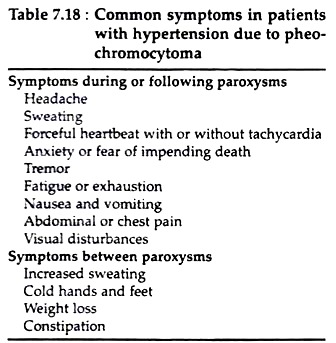The following points highlight the three major disorders in adrenal medullary functions. The disorders are: 1. Hypo Function 2. Hyper Function 3. Pheochromocytoma.
Disorder # 1. Hypo Function:
Hypo function of adrenal medulla is rare. However, it alone probably occurs only in case of adrenocortical steroid replacement therapy following adrenalectomy. Patients with autonomic insufficiency also show deficiency of adrenal medullary epinephrine secretion and can have minor defects in recovery from insulin-induced hypoglycemia.
Patients with generalized autonomic insufficiency usually have orthostatic hypotension.
Disorder # 2. Hyper Function:
The hyper function of adrenal medulla is of less importance since these tissues without sympathetic nervous system are not known to play any significant role in essential blood pressure control.
ADVERTISEMENTS:
Catecholamines can increase blood pressure by increasing cardiac output, by increasing peripheral resistance through their vaso-constrictive action on the arteriole, and by increasing renin release from the kidney, leading to increased circulating levels of angiotensin II.
Disorder # 3. Pheochromocytoma:
Pheochromocytomas are tumors arising from chromaffin cells in the sympathetic nervous system. These release epinephrine or norepinephrine (or both) and in some cases dopamine into the circulation.
ADVERTISEMENTS:
In addition to catecholamines such tumors are reported to secrete variety of peptides, including somatostatin, β-endorphin, lipotropin, interleukin-6, parathyroid related protein, calcitonin, gastrin, insulin like growth factors, neuropeptide y and serotonin.
Commonly reported symptoms and signs are listed in Table 7.18. Persistently secreting tumors may cause increased metabolic activity resulting in heat intolerance, increased sweating and weight loss or lack of weight gain. The effects of catecholamine excess on insulin release can produce hyperglycemia and glucose intolerance. Hypertension is usually present.
Wide fluctuations of blood pressure are characteristic, and marked increase may be followed by hypotension and syncope. Chronic constriction of the arterial and venous beds leads to a reduction in plasma volume in most cases with such tumors. The inability to further constrict these vessels upon arising causes the postural hypotension that is characteristically observed in pheochromocytomas.
